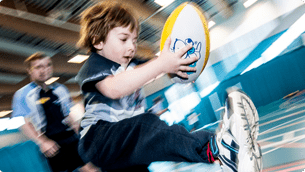
If you have a child who wants to play rugby, or you’re keen to introduce them to the game, then you’re probably wondering what age they can start playing. As a parent of a keen rugby player I know I looked into it. So I thought I’d write this post to share what I know.
Children can start rugby training at their local club when they are 5, as long as they are in year 1 of primary / elementary school. They can’t start playing matches until they are at least 6 years old or in year 2 of primary / elementary school.
For those of you with physically energetic toddlers (hmm…. so that’d be a few of you then), 5 may seem like a long way off, but don’t fret as there is good news. Your child can be introduced to aspects of the game from younger than 5. There are companies out there which offer rugby play programmes, some for children from the age of 2 onwards.
Kids rugby – the age they can start from and the type of rugby they can play
Rugbytots

You can familiarize your child with the concept of rugby and get them playing variants of the game when they’re younger than 5. To do this you’ll need to find an independent company that offers rugby play programmes for children who are too young to train or play at a local club.
Probably the best known of these is Rugbytots, which was started in the UK in 2006. They offer classes in 20 countries and have over 80,000 children involved in their programmes worldwide.
Our fun, structured play sessions take children on a journey of sporting imagination with engaging and energetic coaches supporting them every step of the way whilst teaching how to catch, pass, kick, run with the ball and play as part of a team.
rugbytots.co.uk
Rugbytots offer specifically designed programmes for the gentle introduction of rugby to three different age brackets:-
| Age | Class duration |
| 2 – 3.5 year olds | 30 minutes |
| 3.5 – 5 year olds | 45 minutes |
| 5 – 7 year olds | 45 minutes |
The classes (oh and by the way parent participation is suggested) are held indoor or outdoor depending on weather conditions and the facilities offered by the class location.
The play sessions are non-contact (no tackling) and include activities like running, kicking, passing and catching; all which help develop balance, agility and awareness of space.
You’ll need to book classes in advance by the ‘term’ which usually works out at around 8 sessions. That said you’ll basically get 2 taster sessions, because if your child doesn’t want to go back after the first 2, then you’ll get a full refund.
Class sizes are up to 12 children with one coach, or 14 children with one coach and an assistant coach.
Take a look at this video of a Rugbytots class in action.
Just a heads up and in case you missed it when mentioned above, there are other companies about that offer a similar sort of introduction to rugby for toddlers and kids under 5.
Children’s rugby
Which rugby age group ties in with which school year group can be a bit confusing, so I decided to lay it out in this table:-
| School year | 1 | 2 | 3 | 4 | 5 | 6 |
| Rugby Age grade | U6 | U7 | U8 | U9 | U10 | U11 |
Children’s U6
Your child can start rugby training at a local club when they’re 5 years old. Bear in mind though that they need to be in year 1 of primary / elementary school. These U6 sessions are non-contact and focus on the key skills like passing and kicking, defending and running.
The last 20 minutes of the sessions that my son Arlo attended in Devon UK, were often a small game of tag rugby (known also as rip rugby due to the action of ripping the tag from the belt) without a ball, which is basically like non-contact British Bulldog (ever heard of that?) with belts and tags. It’s amazing watching the kids develop their running and defending skills through playing this game.
What I really liked about the U6 rugby sessions was the way the coaches introduced and taught the core rugby values of teamwork and respect.
Children’s U7
Once they hit 6 and move up into year 2 of primary / elementary school, kids can start playing matches in the form of mini rugby. It’s tag rugby, which is a non-contact version of the sport; with the action of ripping a tag from the player’s belt, or placing two hands on the players hips, replacing the tackle. It is played on smaller pitch sizes with a reduced number of players on each team and match times of around 20 minutes.
Because mini rugby at this junior level isn’t directly governed by the International Rugby Board, countries employ varied versions of the mini rugby framework. This results in subtle variations of the game being played across the globe.
Children’s U8 & U9
Depending on where you are in the world, contact rugby is introduced to children in either year 3 or year 4 of primary / elementary school, which is the U8 or U9 age bracket.
If you want to find out more about the phased introduction of the contact game for kids, you can check out this post which covers contact rugby and how old you need to be to play it in a whole load more detail.
How long do children’s rugby matches last?
Game and match times for children vary depending on the age bracket age and the country they play in. Check out the table below to see the maximum duration for kid’s rugby matches in different countries.
| U7 | U8 | U9 | |
| USA | 10 – 30 MINS | 10 – 30 MINS | 10 – 30 MINS |
| CANADA | 20 MINS | 20 MINS | 20 MINS |
| NEW ZEALAND | 40 MINS | 50 MINS | 50 MINS |
| AUSTRALIA | 30 MINS | 30 MINS | 40 MINS |
| SOUTH AFRICA | 15 MINS | 20 MINS | 40 MINS |
| ENGLAND | 20 MINS | 20 MINS | 30 MINS |
| WALES | 20 MINS | 20 MINS | 20 MINS |
| SCOTLAND | 20 MINS | 20 MINS | 20 MINS |
| IRELAND | 10 – 30 MINS | 30 MINS | 30 MINS |
What size ball do children play rugby with?
Rugby balls come in 5 or 6 different sizes depending on the brand making them. It’s important for kids to play with the ball size that’s been designed for their age, so that they can develop fundamental skills like catching and passing without hindrance. Playing with an oversized ball will make catching, passing and kicking that much harder for a child and will ultimately slow down their progress.
Here’s a table of the different ball sizes and what age range they’re suited for.
| Rugby ball size | Dimensions | Player Age |
|---|---|---|
| Mini | Length 160mm, Girth 315mm | Ages 6 and below |
| Midi | Length 215mm, Girth 420mm | Ages 6 and below |
| Size 3 | Length 255mm, Girth 535mm | Ages 7-9 |
| Size 4 | Length 275m, Girth 545mm | Ages 10-14 |
| Size 5 | Length 285mm, Girth 585mm | Ages 15 upwards |
Why is rugby good for kids?
Rugby is a fantastic game which teaches children the values of teamwork, sportsmanship and respect for one another. Through playing rugby they have the opportunity to learn and develop new skills which in turn will build their own self-confidence.
Here are just a few reasons why your child should give rugby a try.
- For the opportunity to develop strong friendships outside their existing peer groups at school.
- Rugby is a physically active game which will improve their fitness level.
- Through rugby, their running skills and in turn, balance and agility, will naturally develop and improve.
- For the mental workout – the strategies of the game encourage concentration and mental focus.
- Big or small, fast or slow, rugby is a game for everyone and is a team sport. Being a part of that team develops confidence, strength of character and respect for others.
- For the fun!
